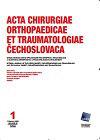[使用前外侧锁定钢板微创接骨治疗跟骨骨折]。
摘要
研究目的跟骨骨折的扩大外侧入路与感染的高风险相关。这种风险可以通过使用微创方法来降低。跗骨窦入路可以很好地观察跟骨后关节面,也可以作为一种微创手术。作者介绍了他们第一次使用经跗骨窦入路插入的前外侧锁定钢板对关节凹陷跟骨骨折进行接骨的经验。材料和方法在2020年2月1日至2022年1月31日期间,作者所在部门的18名患者接受了前外侧锁定钢板治疗(3名女性,15名男性)。11处骨折根据Sanders分类为Ⅱ级,Five分类为Ⅲ级,2处骨折分类为舌型(如Essex Lopresti所述)。骨折采用跗骨窦入路切开复位,前外侧锁定钢板结合无头螺钉接骨。检查了以下因素:受伤时间、手术持续时间、复位质量(术后多平面CT扫描控制)、伤口和技术并发症、治疗后复位损失、药物滥用和合并症。随访时间为12-36个月(中位数17个月)。术后一年,使用AOFAS Hindfoot评分评估功能结果。结果成功治愈最常见的负面倾向是吸烟(9例)、酗酒、药物滥用、轻度精神发育迟缓、人格障碍、胰岛素依赖性糖尿病和癫痫(各1例)、甲状腺功能减退和支气管哮喘(各2例)。测量从受伤到手术的时间和手术的持续时间。复位质量优良的12例患者(脱位小于1mm),良好的6例患者(位错小于2mm),组中不存在大于2mm的脱位。在一个病例中,由于螺钉错位进入距下关节而进行了翻修手术,在两个病例中观察到伤口愈合延迟。没有发生深部手术部位感染或复位失败的病例。一年后AOFAS平均得分为85分。最常见的抱怨是疤痕疼痛或不适。讨论目前对跟骨骨折骨合成的研究支持跗骨窦入路,因为与扩展外侧入路相比,其创伤相关并发症的风险较低。跗骨窦入路需要使用与传统跟骨板不同的骨合成材料。如果要使用传统的锁定钢板,则必须修改手术入路。2021年,Wang等人发表了一个中间步骤,该步骤可以减少早期并发症,并使用通过跗骨窦入路插入的传统锁定跟骨钢板,并增加一个切口。当进行髓内钉固定时,也使用跗骨窦入路,这是评估骨合成刚性的生物力学研究的首选方法。然而,当比较钉子和锁定板时,差异是微不足道的。前外侧锁定钢板的使用由Xie等人提出,其结果与我们自己的患者组相似。结论随访组患者的结果证实了目前文献报道的睑板窦入路并发症发生率低。同时,即使在复杂的骨折中,它也为复位提供了很好的选择。对于成功的骨合成,可以使用带无头螺钉的前外侧锁定板。即使在高危患者中,术后并发症的发生率也很低。腓肌腱粘连可以通过去除材料和释放组织来治疗。他们可以通过良好的物理治疗来预防。关键词:跟骨,接骨术,前外侧板,腓肌腱,跗骨窦入路。PURPOSE OF THE STUDY Extended lateral approach to calcaneus fractures is associated with a high risk of infection. Such risk can be reduced by using mini-invasive approaches. The sinus tarsi approach provides a good overview of the posterior joint facet of the calcaneus and can also be done as a mini-invasive procedure. The authors present their fi rst experience with osteosynthesis of joint depression calcaneal fractures using the anterolateral locking plate inserted through the sinus tarsi approach. MATERIAL AND METHODS During the period from 1 February 2020 to 31 January 2022, 18 patients were treated by the anterolateral locking plate in the authors' department (3 women, 15 men). Eleven fractures were classifi ed according to Sanders as IInd grade, fi ve as IIIrd grade and two fractures were classifi ed as tongue-type (as described by Essex-Lopresti). The fractures were treated by open reduction through the sinus tarsi approach and osteosynthesis by the anterolateral locking plate combined with headless screws. The following factors were examined: time from injury, duration of surgery, quality of reduction (post-op control with multiplanar CT scans), wound and technical complications, loss of reduction after treatment, substance abuse and comorbidities. The follow-up was 12-36 months (median 17). At one year after surgery, the functional outcomes were evaluated using the AOFAS Hindfoot score. RESULTS The most common negative predispositions for successful healing were smoking (9 cases), alcohol abuse, drug abuse, mild mental retardation, personality disorder, insulin-dependent diabetes and epilepsy (1 case each), hypothyreodism and bronchial asthma (2 cases each). The time from injury to surgery and duration of surgery surgery were measured. The quality of reduction was excellent in 12 patients (dislocation less than 1 mm), good in 6 patients (dislocation less than 2 mm), dislocation more than 2 mm was not present in the group. In one case, a revision surgery was performed because of screw malposition into the subtalar joint, delayed wound healing was observed in two cases. There was no case of deep surgical site infection or loss of reduction. The mean AOFAS score after one year was 85 points. The most common complaints were scar pain or discomfort. DISCUSSION The current studies on osteosynthesis of calcaneal fractures favor the sinus tarsi approach for its lower risk of wound-related complications compared to the extended lateral approach. The sinus tarsi approach requires the use of different osteosynthetic material than the conventional calcaneal plate. If a conventional locking plate is to be used, the surgical approach has to be modifi ed. In 2021, Wang et al. published an intermediate step leading to the reduction of early complications and the use of conventional locking calcaneal plate inserted through the sinus tarsi approach, with an additional incision. The sinus tarsi approach is used also when intramedullary nailing is performed, which is preferred by biomechanical studies evaluating the rigidity of osteosynthesis. However, when comparing nails and locking plates, the differences are insignifi cant. The use of anterolateral locking plates was presented by Xie et al., with results similar to those of our own group of patients. CONCLUSIONS The results of the followed-up group of patients confi rm low complication rate of the sinus tarsi approach as reported by current literature. At the same time, it provides good options for reduction even in complicated fractures. For successful osteosynthesis, the anterolateral locking plate with headless screws may be used. The incidence of post-operative complications is low even in high-risk patients. Adhesions of peroneal tendons can be treated with material removal and tissue release. They could be prevented by good physiotherapy. Key words: calcaneus, osteosynthesis, anterolateral plate, peroneal tendons, sinus tarsi approach.

 求助内容:
求助内容: 应助结果提醒方式:
应助结果提醒方式:


